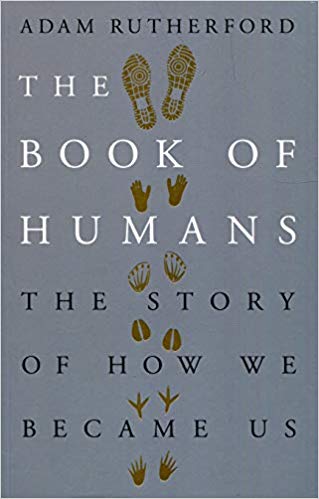Adam Rutherford, that prolific public intellectual of the life sciences, has now put his words where his heart has quite evidently been for a long time. In this, his 2018 book, The Book of Humans: The Story of How We Became Us (and it is perhaps aptly renamed in the 2019 USA version—Humanimal: How Homo Sapiens Became Nature’s Most Paradoxical Creature—A New Evolutionary History), Rutherford widens his remit from explaining the technical arguments and resultant ideas of evolution (Creation, 2014) and of human migration (A Brief History of Everyone Who Ever Lived, 2016) to the far more ambitious task of explaining to us that, while ‘different’ and ‘interesting’ we may well be from other animals, we are not particularly ‘special’. ‘Good luck with that’, I think, but that is the sort of cynical lethargy that Rutherford will have no truck with. And my goodness, he (almost?) persuades me out of mine.
Even in this age of easy-trivial fingertip information, Rutherford’s casual erudition is impressive, and his chatty, deprecating (both self- and nonself-) humour carries it effortlessly. In consequence, much of the book is a series of endlessly entertaining wide-eyed-oh-my-goodness-did-you-know stories. Most of these stories are about all the many instances of non-human animals doing things that we thought (some of us still think) only humans did. In the first part of the book, he talks about tools and shows us, not just that many other animals make and use tools, but the bewildering lack of any pattern in which species make tools and which don’t. He talks about how ‘we’, as in human-like animals, used a relatively unchanging set of tool technologies for hundreds of millennia and then, relatively recently, upped our game. He talks about the fact that we use an extraordinary diversity of sexual interactions for non-reproductive purposes, and rollicks his way through a gallimaufry (his word, used elsewhere) of non-human sexual antics that collectively say, somewhat tritely, one would think, that other animals in all likelihood have all kinds of sex for fun, too.
This is salutary, certainly, in taking us down a peg, and yet, it also provides a paradoxical sense of anthropomorphic amusement. Rutherford, who does his best to keep warning us not to anthropomorphize, keeps doing precisely that every once in a frequent while.
In the second part of the book, Rutherford takes on somewhat more nuanced ‘human’ capacities––speech, language, symbolism and consciousness. In fact, his idea of ‘consciousness’ just precedes his idea of ‘regret’, leaving one expecting that ‘ethics’ will arrive as the next step. It does not, though. Instead, what Rutherford is focused on is to show us how our ‘bodies’ and ‘minds’ have grown together in inextricable linkage. He describes at length how it is not simply our ‘brains’ but other body parts including throats and hands, the genes that control them, their design and functioning, that all participate in the making of our humanness, and it is no surprise that he ends this journey in the cultural space of teaching each other.

